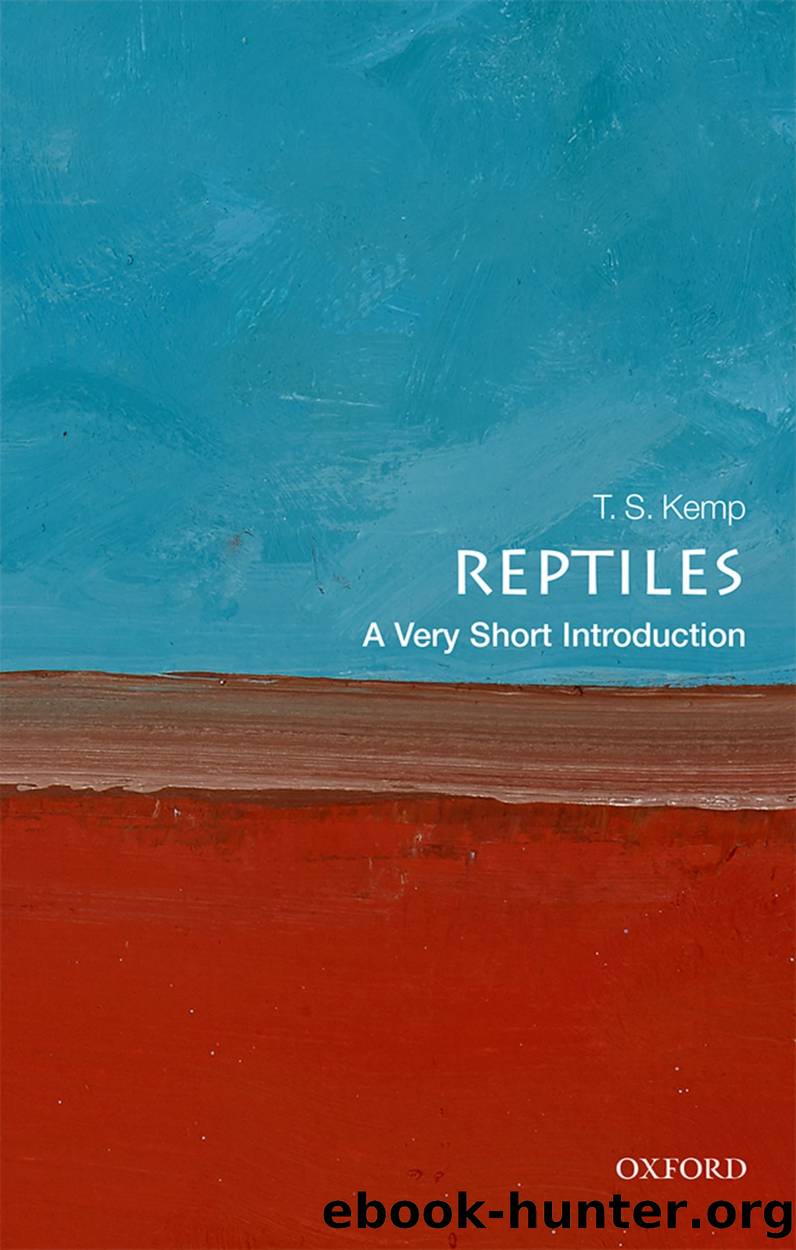Reptiles by T. S. Kemp

Author:T. S. Kemp [Kemp, T. S.]
Language: eng
Format: epub
ISBN: 9780192529015
Publisher: OUP Oxford
Published: 2018-12-14T00:00:00+00:00
Chapter 4
Snakes
No group of animals has attracted more aversion and fear in people than snakes. It comes from a combination of their potentially fatal venomous bite, their creepy furtiveness as they lie in wait and appear by surprise, and the mistaken belief that they are unpleasantly cold and slimy. But from our point of view, snakes are to be admired as possibly the most superbly adapted hunting organisms in the natural world. A typical snake does not need to chase and tussle with its prey like other predators do, even though the prey itself can be so large that the snake only needs to feed once every few weeks.
The roughly 3,500 species of snakes are really a group of limbless lizards, although they are so distinctive, with so many unique features, that they are placed in their own reptile subclass, Ophidia or Serpentes. There is uncertainty about exactly where on the lizard evolutionary tree they fit. For a long time they were believed to be related to the somewhat similar limbless, burrowing worm-lizards (amphisbaenids) and blind skinks (dibamids), described in Chapter 3. But molecular evidence has shown that the similarities are actually due to independent, parallel evolution rather than to sharing a common limbless ancestor. Instead, the snakes evolved from deep within the lizard evolutionary tree, with no particularly close living relatives. The least modified of the living snakes are the blind snakes, a group given the name Scolecophidia, which means worm snakes. They are small, burrowing snakes whose eyes are greatly reduced, as their common name implies. They do not have the broad belly scales of all the more progressive snakes, and feed on small items of prey such as ants and termites. The rest of the snakes are members of the far more diverse group called Alethinophidia, which means âtrueâ snakes. These do have wide belly scales, and their skulls are specialized for feeding on large prey.
Today the snakes, like the lizards, have a worldwide distribution and occupy a great many habitats, from deserts to rain forests and seas, even including a small number of species that survive above the Arctic Circle. But it is the tropics that hold the greatest richness of diversity. Unlike lizards, snakes show very little variation in their general body form. All the living species completely lack limbs, apart from a pair of minute horny spurs alongside the cloaca in boas and pythons, a vestige of the hind limb that is used to stimulate the female in copulation. The number of vertebrae in the vertebral column is huge, 200â400. Each one attaches to the next by a strong ball-and-socket joint which allows bending, and four interlocking bony contacts to make sure they are not easily disarticulated. Snake scales are overlapping and flexible, and the single row of very wide scales along the belly found in most snakes are in contact with the ground, helping to increase the traction.
There is a certain amount of argument about how the snake ancestor lived. Most zoologists believe
Download
This site does not store any files on its server. We only index and link to content provided by other sites. Please contact the content providers to delete copyright contents if any and email us, we'll remove relevant links or contents immediately.
Essentials of Geology by Stephen Marshak(389)
Spectral Geometry and Inverse Scattering Theory by Huaian Diao & Hongyu Liu(280)
Probably Overthinking It: How to Use Data to Answer Questions, Avoid Statistical Traps, and Make Better Decisions by Allen B. Downey(269)
The Readable Darwin by Pechenik Jan A.;(263)
Hydrocarbon transformations in sediments from the Cathedral Hill hydrothermal vent complex at Guaymas Basin, Gulf of California ââ¬â A chemometric study of shallow seep architecture by unknow(262)
How to succeed in EPSO numerical reasoning tests by Franco Reverte José María(239)
Great Ways to Learn Anatomy and Physiology by McKissock Charmaine;(232)
Quantum International Relations by James Der Derian(231)
Research and Publication Ethics by Santosh Kumar Yadav(231)
Mathematical Models in Economics. Lections by Shananin(230)
Weathering: Types, Processes and Effects: Types, Processes and Effects by Matthew J. J. Colon(226)
Dark Matter in the Universe by John N. Bahcall(223)
Fusion of Defects by Arthur Bartels; Christopher Douglas; André Henriques(214)
Cosmic Rays by Alessandro De Angelis(211)
Sampling by Lohr Sharon L.;(205)
Mathematics Booster-1 by Singh Manoj Kumar(205)
The Structure of Scientific Inference by Mary B. Hesse(204)
Pearls from a Lost City: The LVOV School of Mathematics (History of Mathematics) (History of Mathematics, 40) by Roman Duda(199)
Flora Unveiled by Taiz Lincoln;Taiz Lee;(190)
